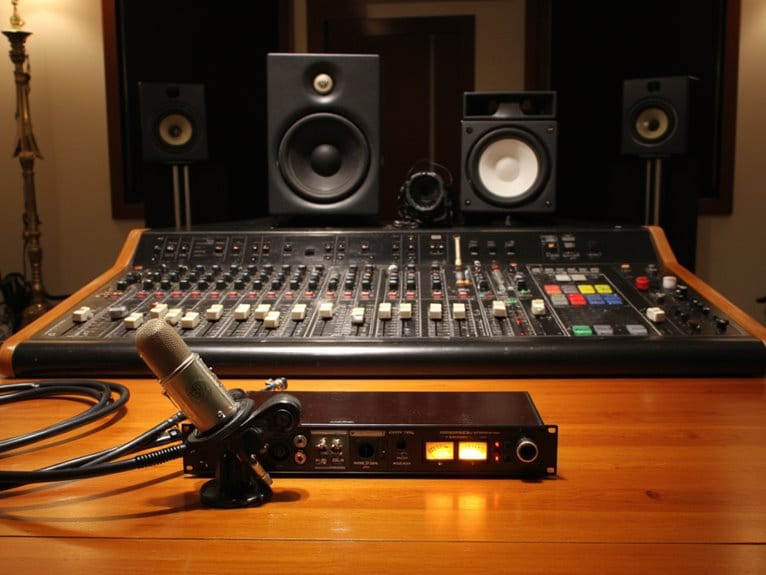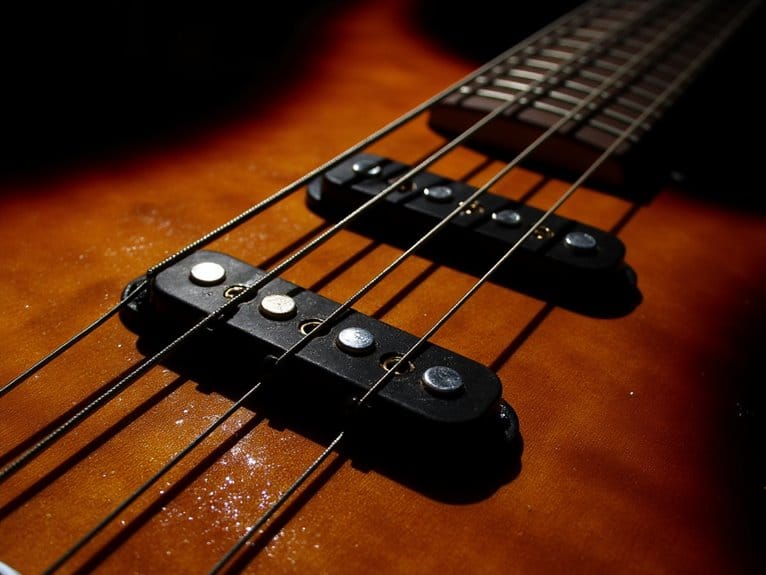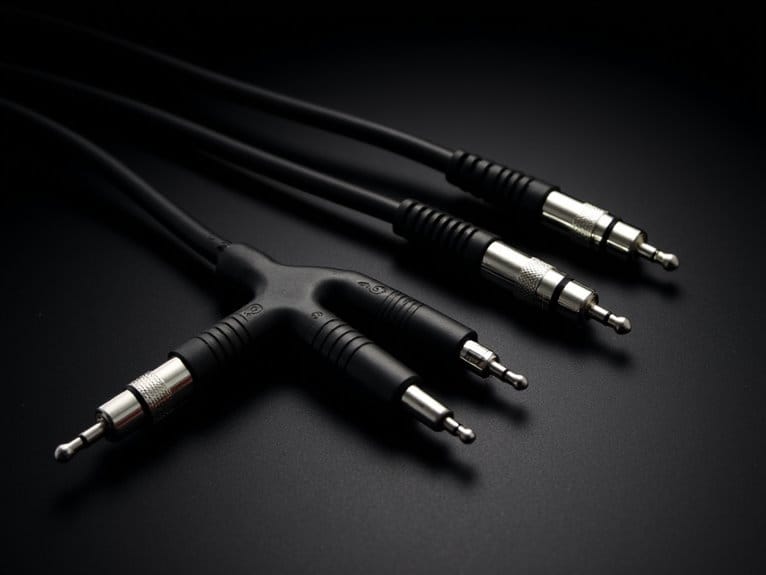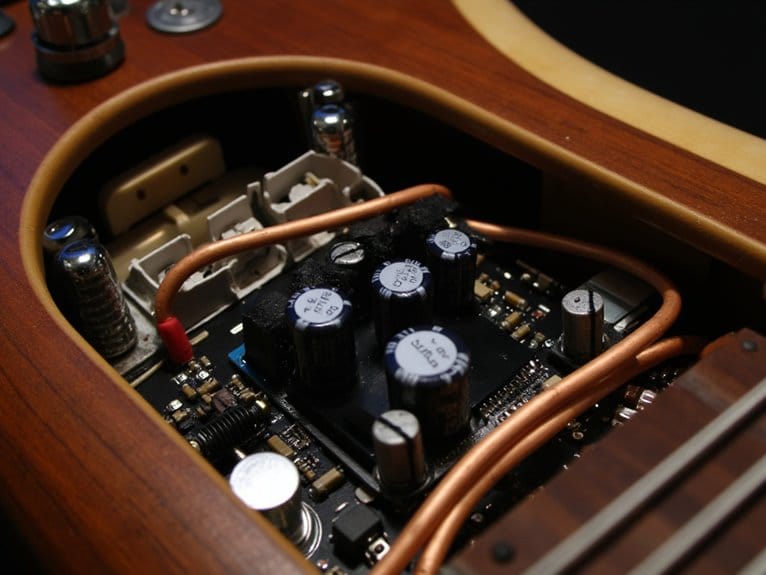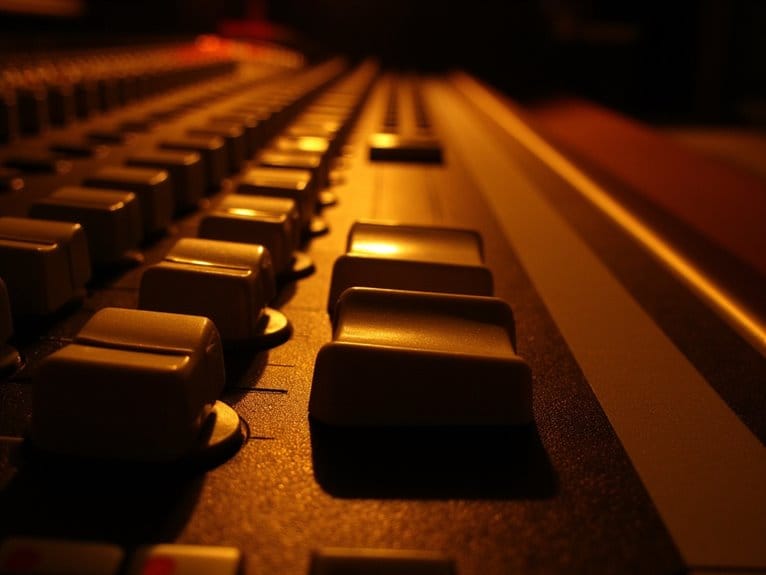The Complete Guide to Signal Flow: From Source to Speaker
You’re probably losing audio quality because your signal flow isn’t optimized from microphone to speaker. Your audio travels through preamps that boost weak mic signals, equalizers that shape frequency response, compressors that control dynamics, and converters that bridge analog-digital domains. Poor gain staging creates noise artifacts, while cable management and processing order greatly impact clarity. Digital workstations offer flexible routing, but understanding each component’s role in your signal chain will reveal the remaining secrets to pristine audio reproduction.
We are supported by our audience. When you purchase through links on our site, we may earn an affiliate commission, at no extra cost for you. Learn more.
Notable Insights
- Audio signal flow begins with microphones converting acoustic vibrations into electrical signals that travel through multiple processing stages.
- Microphone preamps, equalizers, compressors, and converters condition signals by boosting levels, shaping frequency response, and managing dynamics.
- Digital Audio Workstations replace hardware routing with flexible virtual pathways, allowing efficient signal splitting, merging, and processing.
- Proper gain staging prevents distortion while quality cables and electrical isolation maintain signal integrity throughout the chain.
- Studio signal flow emphasizes controlled processing for recording, while live sound prioritizes real-time routing for immediate performance adjustments.
Understanding the Fundamentals of Audio Signal Path
When I first started working with audio equipment, I’ll admit I was completely baffled by how a simple vocal recording could travel through so many different components before reaching my speakers.
But understanding signal flow turned out to be the foundation that transformed my confusion into confidence.
At its core, signal flow describes the route your audio travels from source to destination, involving multiple processing stages that capture, condition, and reproduce sound.
You’ll encounter this pathway whether you’re recording vocals, mixing tracks, or simply playing music through your speakers.
The journey begins when sound waves create acoustic vibrations, which microphones convert into electrical signal representation.
Then it flows through preamps, processors, converters, and finally back to sound waves through your monitors. Understanding this signal path helps you identify exactly where problems occur when troubleshooting audio issues. Maintaining a clean signal path is crucial for high-quality recordings and prevents unwanted noise or interference from degrading your audio. Modern audio interfaces with ASIO drivers provide lower latency and better performance for professional recording applications.
Essential Components and Their Role in Signal Chain
Now that you understand how audio travels from source to destination, let’s examine the specific components that shape, process, and condition your signal along its journey.
Microphone preamps provide that essential first boost, transforming weak mic signals into workable line levels while adding subtle tonal coloration that defines your sound’s character. Quality preamps should deliver 25-75dB of clean gain to properly amplify dynamic microphones and condensers without introducing unwanted noise or distortion.
Various equalizer types then sculpt frequency response, cutting problematic ranges and enhancing desirable elements for improved clarity.
Dynamic processing through compressors smooths volume inconsistencies, creating polished, professional results while offering effective noise reduction.
Signal conversion components like DACs and ADCs bridge analog and digital domains, directly impacting overall audio fidelity.
Meanwhile, proper cable integrity guarantees clean transmission between components, preventing interference and maintaining signal quality throughout your chain.
Signal Flow in Digital Audio Workstations and Modern Production
The modern digital audio workstation fundamentally transforms how we approach signal flow, replacing traditional hardware routing with flexible virtual pathways that offer unprecedented control over your audio journey.
Digital audio workstations revolutionize signal routing by replacing physical hardware limitations with infinitely flexible virtual pathways and unprecedented creative control.
Your DAW’s digital routing capabilities allow you to split, merge, and redirect signals through complex configurations that would require extensive hardware in analog setups.
Understanding insert processing order becomes essential since each plugin affects the next, and signal integrity depends on proper gain staging throughout your virtual chain. Each processing element in your plugin chain acts as a gain stage, where careful level management prevents distortion and maintains optimal signal quality.
Pre-fader sends tap signals before your track fader, while post-fader sends maintain consistent effect ratios when you adjust levels.
Monitoring signal at different stages helps identify issues early, ensuring your audio maintains quality from input through processing to final output conversion.
Common Problems and Troubleshooting Techniques
Although digital workflows have streamlined many aspects of audio production, I’ve found that signal flow problems still plague even experienced engineers. These issues often stem from fundamental mistakes that compound throughout your entire chain.
Poor gain staging remains the biggest culprit, where improper level matching between +4 dBu professional gear and -10 dBV consumer devices creates noise artifacts that’ll haunt your mix.
I’ve learned that cable management isn’t just about aesthetics-tangled cables introduce noise, while loose connectors cause those dreaded pops and crackles.
Electrical interference from heating systems and thermostats can wreak havoc, requiring isolated ring mains for serious setups.
Finally, signal processing order matters tremendously; placing pitch correction before dynamics processing prevents unnecessary noise floor elevation.
Studio Vs Live Sound Signal Flow Applications
While studio and live sound environments share fundamental signal flow principles, I’ve discovered that each domain demands drastically different approaches to equipment selection, processing techniques, and routing strategies that’ll shape your entire workflow.
In studios, you’ll route signals through multiple processors like preamps, compressors, and EQs, focusing on nuanced studio engineer techniques for tracking and mixing perfection.
Live sound, however, prioritizes real-time routing through PA systems, stage monitors, and mixing consoles where immediate live sound adjustments become critical for performer monitoring and feedback control.
Studios offer controlled acoustic environments with nearfield monitors, while live venues present unpredictable acoustical challenges requiring aggressive high-pass filtering and consistent compression levels to maintain signal integrity throughout variable performance spaces.
On a final note
You’ve now grasped signal flow‘s essential journey, from microphone capsules capturing acoustic energy to speakers translating electrical signals back into sound waves. Whether you’re tracking vocals in your bedroom studio or mixing a live concert, understanding each component’s role-preamps, converters, processors, and monitoring chains-empowers you to diagnose issues quickly and optimize your audio quality. Master these fundamentals, and you’ll troubleshoot signal problems with confidence while achieving professional results.

